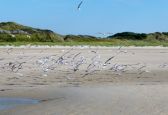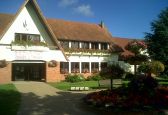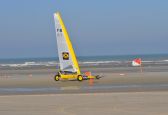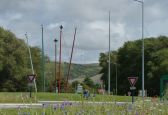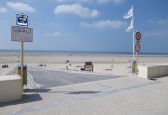Auparavant érigé au sein des dunes de Camiers, le Phare Armand est un véritable symbole maritime marquant l’entrée de la Baie de Canche. Il est dorénavant implanté au sein du giratoire de la RD 940

Le Phare Armand
Également connu sous le nom de Phare de Camiers ou Phare des Dunes de Camiers, le Phare Armand est un véritable symbole maritime marquant l’entrée de la Baie de Canche.
Auparavant érigé au sein des dunes de Camiers à l’extrémité de la rive droite de l’estuaire de la Canche, il a été nommé ainsi en l’honneur de son premier gardien, François Ramet, surnommé le Père Armand.
Le phare qui se trouve sur le giratoire de la RD 940 est le successeur du phare initial, allumé pour la première fois le 15 septembre 1874. Au cours de son histoire, le phare Armand a connu cinq versions différentes.
La première version, établie en 1874, était constituée de deux feux d’alignement avec un logis intégré. Ce phare a été détruit, accidentellement ou intentionnellement, par les Allemands pendant la Seconde Guerre mondiale.
Un phare de remplacement a été construit en novembre 1944, mais il a souvent subi des pannes et a dû être réparé et déplacé plusieurs fois en raison de l’évolution des dunes.
Un troisième phare a été construit en août 1956 à l’emplacement initial du phare Armand. Puis, en juin 1960, un nouveau pylône est installé. Le 24 février 1965, il est muni d’un feu à trois secteurs. Sa portée est de 10 milles pour le secteur blanc et de 7 milles pour les secteurs rouges et verts à deux occultations toutes les 6 secondes.
Après la chute du pylône inutilisé, la commune de Camiers-Sainte Cécile a exprimé le désir de le récupérer auprès des « Phares & balises » pour l’implanter sur le rond-point de la RD940.
Cet emplacement marque l’entrée Nord du territoire de la Baie de Canche par la route.
Il convient de noter que le Phare Armand est parfois appelé Feu de Lornel ou Phare de Lornel, en référence au premier feu implanté en 1805 dans les dunes de Camiers près de la pointe de Lornel.

The Armand Lighthouse
Also known as the Camiers Lighthouse or Camiers Dunes Lighthouse, the Armand lighthouse is a true maritime symbol which marks the beginning of the Canche Bay.
Previously located within the Camiers dunes on far end of the right shore of the estuary of the Canche river, it was named in honnor of its first keeper, François Ramet, nicknamed Father Armand.
This current lighthouse is the successor of the original one, lit for the first time on September 15th 1874. During its lifespan, the Armand lighthouse has had five different versions.
The first version, establisement in 1874, was made of two alignment lights with integrated lodging. The lighthouse was destroyed by the Germans, perhaps by accident or not, during World War II.
A replacement lighthouse was then built in November of 1944, but it often suffered breakdowns and had to be repared and moved several times because of the evolution of the dunes.
A third lighthouse was built in August of 1956 at the same location as the initial Armand lighthouse. Then, in June of 1960, a new mast was installed. On February 24th 1965, it was fitted with a three sector light. Its reach was 10 miles for the white sector and 7 miles for the red and green sectors aty two occulations at every 6 seconds.
After the fall of the unused mast, the town of Camiers- Sainte Cécile expressed interest in recuperating it from “Phares & balises” to install it on the roundabout of the D940 road.
This location marks the Northern entrance of the Canche Bay territory by road.
It is worth noting that the Armand lighthouse is sometimes called Lornel Light or Lornel Lighthouse, in reference to the first lighthouse installed in 1805 in the Camiers dunes near the Lornel point.
Zoom : lighthouse and maritime fire
A lighthouse and a maritime fire both play a crucial role for navigation, but they differ in terms of structure and purpose.
A lighthouse is an elevated tower equipped with a powerful light source at its top. It serves as a permanent landmark to help ships navigate at sea, especially at night or with bad visibility. Thanks to its rotating light beams, seamen can estimate their position and avoid danger.
A maritime light is a generic term designating any light source installed for navigation. It can be a beacon light, buoy light or lighthouse light. The maritime lights can vary in size, form and purpose. Some warn about the presence of danger such as corals or sandbanks, while other mark the entrance of a port or waterway.
To summarize, all lighthouses have maritime lights, but not all maritime lights are located within lighthouses.

